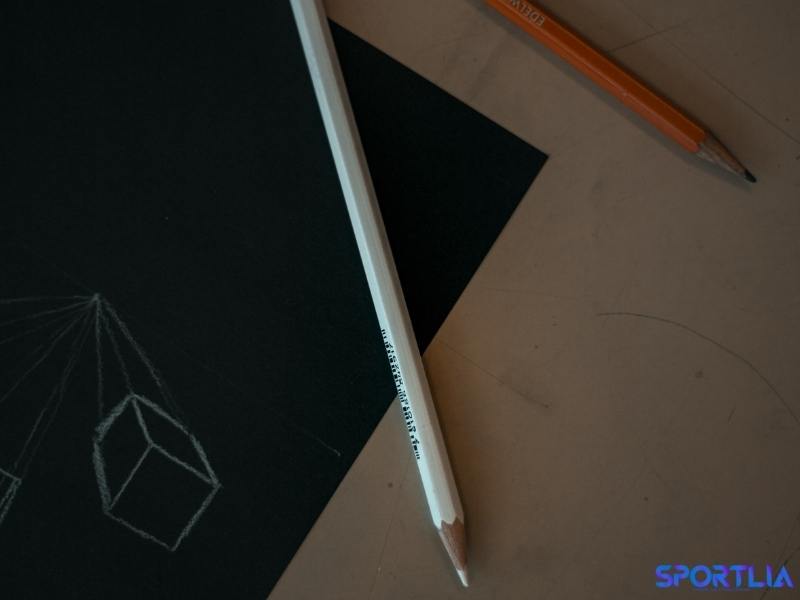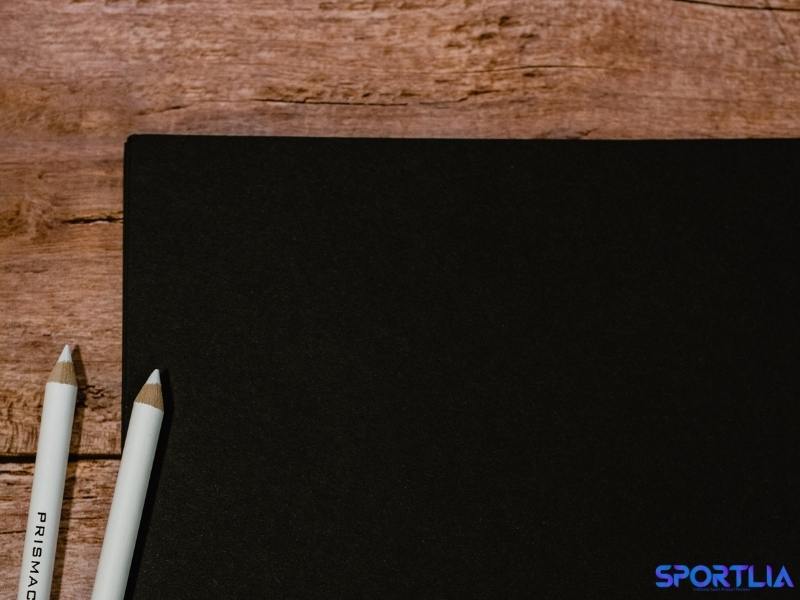Wondering how to use graphite paper to transfer images? Well, it’s pretty simple!
Graphite paper is a versatile material that can be used in many different ways.
Graphite paper is used to sketch out ideas before committing to parchment or canvas.
It also has many different styles like tonal drawing or hatching that artists create depth and texture in their artwork.
It’s tough to trace drawings using regular sheets of paper, but graphite paper is translucent enough to allow the picture underneath to show through.
Artists use this method in their work to draw their designs for paintings or sculptures. This helps you design and understand what you want your finished product to look like.
Graphite paper is also called a working pad or drawing paper, and graphite is made from carbon, so when you put water on the paper’s surface, it turns completely black.
However, the paper does not absorb the pencil markings; instead, they rest just on top of the white sheet, making your drawings easy to see.
In this guide, we will cover how to use Graphite Paper, what it looks like when dry, wet with water, and wet with oil; which tools work best on it; how graphite papers are typically transferred onto other surfaces such as canvas or wood panel; and finally some tips for preserving your work on this medium.
What is Graphite Paper?
Graph paper is a sheet of paper with horizontal and vertical lines, usually a square grid pattern. It was mainly used to create graphs, charts, and drawings.
You can use graphite paper for drawing or sketching things that will be transferred to another surface.

When you use it on its own, it can become stiff and brittle; however, when mixed with water (into a solution) or with an oil-based medium such as linseed oil or safflower oil (to make the material translucent), the substrate becomes more flexible.
You can even erase the drawing by using a sufficiently dry piece of eraser.
The Graphite Paper comes as a white sheet, but you can change it to any color by adding water or oil to the surface.
How To Use Graphite Paper To Transfer Images
To make a transfer with graphite paper, you first need to prepare the page you’re transferring onto.
- Firstly, you should prepare your materials, take out a coloring page and graphite paper, and place them on a table; also, make sure you have something for drawing, a pencil or pen.
- In the first step, you should place the graphite paper on the Darkside to face the color paper.
- Next, you should place the image you want to transfer or trace on top of the graphite paper.
- To connect the graphite paper to the image, you should place a piece of heavy-weight material on top of everything and rub it over it with a bone folder. Ultimately, using a tap is a great way to hold the color paper and graphite paper together, so when you are tracing, it will not move, and your tracing will be easy and perfect.
- You can use almost any pen for your drawing. Just be sure that the pen should not cause damage to your original picture.
- Start tracing the image and apply a little pressure on the drawing so that tracing lines fully transfer to the graphite paper.
- Finally, once all this is done, you can pull up the graphite paper and see your finished product!
- By doing these steps, you will have transferred your image onto your color sheet. Now your only task is to color over them!
SUPER SIMPLE!
Tips for Preserving Your Work on Graphite Paper
One of the essential things to preserve your work on graphite paper is to avoid smudging what you have drawn.
You should avoid using a wet brush or pen when it’s still wet with ink.
If you need to hold your drawing for an extended period, use heavy weights like books or a stapler.
You can also use contact paper if you are worried about preserving your work in a book.
But make sure that you do not place your drawing on top of another sheet of graphite paper, or else both sheets will damage your pencil markings.
If the ink from the pen is still wet, use a sharp knife to remove it.
You can also blot damp areas with a soft cloth to dry up the excess water, which will help avoid seeping ink.
To begin with, it is necessary that you cut off the excess graphite paper from your drawing.
After this process, ensure that you do not remove the sheet for a certain period because otherwise, you will spoil the entire picture.
Lastly, take care of handling your artwork and protect them using paper, plastic, or even wax paper.
If you wet it first with water, you can use Graphite Paper as an eraser.
It is beneficial when you make a mistake in your drawing and don’t want to ruin the rest of your work!
You need to wet the Graphite Paper with some watered-down dish soap so you can erase your mistakes.
If you don’t want to use dish soap, you should wet the Graphite Paper with water and then rub it on some graphite or charcoal that has already been used.
Do this several times if necessary until all your eraser marks are gone, and you will have a clean slate again!
The best thing about Graphite Paper is that you can use it to create a tonal drawing or hatching. This means that putting down heavy and light lines in the right places will help make your work look more professional and realistic!
You can even draw on top of graphite paper with a regular pencil and then erase it once you’re done.
It is great to test some drawings before doing them on the actual canvas or parchment!
Lastly, artists use many different materials for their artwork, so graphite paper is just one medium they might use.
Make sure you research other art mediums artists use and see what you can learn from each one!
Best Tools for Working with Graphite Paper
Pens/pencil
Pens can be used to create graphite paper drawings. However, some pens are not safe for use with the material and may damage your graphic, so the best option is a pencil.
It is best to use water-based ink when working with this drawing paper.
Brushes
Brushes also work well with graphite paper and a more vivid color scheme.
To create tonal gradations, you should dip your brush in water that is one shade lighter than the desired color you are looking for, then paint over it with a darker shade of paint.
Watercolor Pencils
These pencils are versatile; they can be used as a pen or with softer strokes to create blended colors.
It would help if you remembered that watercolor pencils are not permanent, so be sure to use a fixative after you finish your drawing.
Charcoal
This material is versatile and can create dark, heavy lines or make lighter marks that have a smoky feel.
Remember, charcoal can create very dark marks on the paper; therefore, it is best to have an eraser ready if you make a mistake.
Graphite Paper
You can also use Graphite paper to create your drawing. While you are working, if your pencil is not having the best effect on the paper, it might be too smooth for graphite.
If this happens, try running some sandpaper over one side of the paper to give it a rougher texture. This should help your pencil create darker, better lines!
Erasers
To make corrections in your drawing, you can use rubber erasers or even graphite paper as an eraser if you wet the surface first with some water.
Once you use these materials, store them in a safe place so they do not damage your artwork.
Plastic Sheets
It would be best if you used transparent plastic sheets to protect the paper’s surface from being damaged by other materials in your drawing.
For instance, if you accidentally drip some water on your drawing, then this can cause damage to it. Placing a plastic sheet on your work is a great way to prevent this damage.
Storing Graphite Paper
If you have a finished piece of art on graphite paper, you might want to store it safely, so it does not get damaged or wrinkled.
Do not leave your drawing flat on the table because this could cause unwanted creases in the paper.
Instead, you should try to roll it up and put it in a tube similar to a poster tube.
Another option would be to place your drawing on top of a stack of paper or other pictures so that it does not bend when stored.
Why You Would Use Graphite Paper Over Others
A few reasons you would want to use Graphite Paper over other materials is that it is thin and lightweight, so you can easily carry it with you if you need to.
It also costs less than canvas or paper types and doesn’t require a frame!
Plain graphite paper will work for sketching ideas before committing to more expensive types of writing.
You can add water or oil to the paper’s surface to change its color. Lastly, the paper is non-absorbent and does not wrinkle.

Graphite Paper is available in different colors and can be used for various drawing styles.
It allows artists to create their unique style depending on the color on the paper’s surface.
Artists use graphite paper to sketch ideas before committing to a more permanent form of composition.
It is an excellent way for artists to experiment with color and see specific colors’ effects on their artwork.
Graphite Paper does not absorb the paint, allowing designers to create unique textures in their work that add depth and dimension.
Methods For Erasing Graphite Drawings

You can use a kneadable rubber eraser or even your hands if the drawing is not too detailed. However, if it is too complex, this could tear your paper.
If it is too detailed for your hands, you can use an electric or battery-operated eraser. However, these are more expensive than the two mentioned before.
If any residue is lingering on your paper after erasing it with one of these methods, get a cloth that’s been dampened with water, then gently rub it in a circular motion to make the residue disappear.
Step-1: If you use a rubber eraser, press hard with the eraser, and don’t use too much pressure, as this can tear your paper.
It’s always good to have two or three kneaded erasers on hand if one gets worn out from being used too much.
Step 2: If you use your hands to erase your drawing, then make sure that the paper is on a flat surface that will not be affected by any moisture while rubbing.
Don’t try this on other paper types like wood or cardboard, as they can be easily ruined if you do.
Step-3: If you don’t have an eraser and need to get rid of the graphite immediately, you can use a cloth dampened with water in a circular motion over the entire area where the graphite is present.
Then when you’re done, go over it with a dry section of the same cloth to remove any extra moisture before it has time to soak into your paper.
You might do this several times to eliminate all the wet spots.
Different Styles That Can Be Used on Graphite Paper (Hatching, Cross-hatching) [BONUS POINTS]
Many different drawing styles can be found on graphite paper.
They use hatching to create a smooth transition between two areas and cross-hatching when they want the contrast of lines.
To create hatching, you would draw parallel lines next to each other. This creates a shading illusion since it appears darker in the middle, with more strings.
If you wanted to create cross-hatching, you would draw lines perpendicular to one another and at right angles across each other on top of one another. This makes for strong contrast and is used in tonal drawing.
FAQs – Frequently Asked Questions About Graphite Paper
Where to Find Graphite Paper?
You can find graphite paper online or at art supply stores. A great option is Amazon!
What are the different types of graphite paper?
Graphite paper can come in different types but are usually white on the front side and black on the other side.
How do you know if your graphite is working or not?
If your graphite is working, it will stick and not smudge.
What colors can be created with graphite paper?
Different types of graphite paper can create different colors.
-> Graphite paper is often a white-on-black pattern that can be erased by rubbing the lines with an eraser or covered in water or oil to make it any color you desire.
-> Colored pencils and chalk are another way to get different colors out of graphite, but they will only cover the black sections.
Your graphite may not be working if your drawn lines won’t stay in place and smudge instead; this indicates that you should sharpen your pencils, so there’s more lead on the surface of the graphite, or use a hard drawing pencil with a minor wax binder, so it forces darker tonal values easier.
Is it possible to mix the two types of graphite paper (one with a color and one without)? If yes, then what is the result?
Yes, you can mix the two types of graphite paper as long as both are white. The result is a gray tone when you erase it with an eraser or paint over it for a sketch.
Where should the items be stored when not in use to maintain their quality over time?
The items should be stored in a clean, dry place where they are not subjected to direct sunlight or heat.
If you store the items in the wrong conditions, then over time, it can cause fading and discoloration, leading to pieces being unusable.
Store them near a window if possible so that it’s not too warm or too close to your heat sources like your radiator, stovetop, or heater, as this can make them deteriorate sooner.
The best spot is an area with good airflow and no moisture.
In addition, if you notice any scratches on the surface of your graphite paper after storage, this could indicate that they became damaged from being crumpled up in a pile or bent too much while unrolling them.
How do I transfer my drawing from a sketchbook onto another piece of paper, and how can I prevent it from smudging?
Transferring your drawing is easy if you use graphite paper, a thin sheet with black on one side and white on the other.
The benefit of using this type of paper over regular tracing or transfer paper is that it can be erased by rubbing off with an eraser or painting over it for sketches.
Graphite will not work if you cannot erase it in some way like chalk does because products like watercolor paint will soak into the graphite and ruin your drawing.
To transfer your drawing to another sheet of paper, make sure both are flat and smooth.
Then place your drawing on the new sheet of paper in the same direction as it was on the previous sheet.
Use graphite paper to trace over your sketch until you have a complete outline showing all the details.
To prevent smudging, wait at least twenty minutes after tracing before going over it with a pencil or paintbrush.
If you notice any streaks, then go back over those areas again with an eraser to remove them entirely for the best results.
You should also be careful not to let your hand touch the paper because this can transfer oils from your skin onto the surface, making smudging more likely.
When using graphite paper, do I need other materials like a ruler or compass?
No, you only need a pencil and eraser for drawing on graphite paper.
Rulers and compasses are valuable tools, but they aren’t necessary to have access to when drawing with this type of paper.
Conclusion
Transferring an image to graphite paper is relatively straightforward; you can use any tools for the purpose; you don’t need to purchase a high-quality pen; regular pens or a simple pencil will do the job.
You can further enhance your skills by practicing rough ideas, so I suggest you try simple ideas to see how your graphite paper outputs the tracing lines.
Once satisfied with the output, you can start working on your original product.






